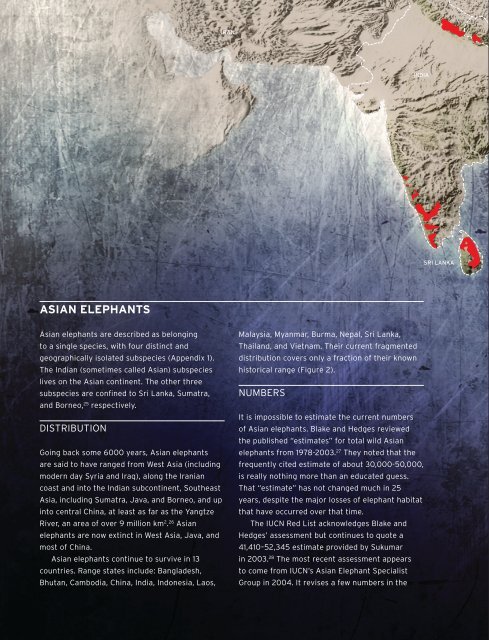ELEPHANTS & IVORY
ELEPHANTS & IVORY
ELEPHANTS & IVORY
You also want an ePaper? Increase the reach of your titles
YUMPU automatically turns print PDFs into web optimized ePapers that Google loves.
ASIAN <strong>ELEPHANTS</strong><br />
Asian elephants are described as belonging<br />
to a single species, with four distinct and<br />
geographically isolated subspecies (Appendix 1).<br />
The Indian (sometimes called Asian) subspecies<br />
lives on the Asian continent. The other three<br />
subspecies are confined to Sri Lanka, Sumatra,<br />
and Borneo, 25 respectively.<br />
DISTRIBUTION<br />
Going back some 6000 years, Asian elephants<br />
are said to have ranged from West Asia (including<br />
modern day Syria and Iraq), along the Iranian<br />
coast and into the Indian subcontinent, Southeast<br />
Asia, including Sumatra, Java, and Borneo, and up<br />
into central China, at least as far as the Yangtze<br />
River, an area of over 9 million km 2 . 26 Asian<br />
elephants are now extinct in West Asia, Java, and<br />
most of China.<br />
Asian elephants continue to survive in 13<br />
countries. Range states include: Bangladesh,<br />
Bhutan, Cambodia, China, India, Indonesia, Laos,<br />
IRAN<br />
Malaysia, Myanmar, Burma, Nepal, Sri Lanka,<br />
Thailand, and Vietnam. Their current fragmented<br />
distribution covers only a fraction of their known<br />
historical range (Figure 2).<br />
NUMBERS<br />
It is impossible to estimate the current numbers<br />
of Asian elephants. Blake and Hedges reviewed<br />
the published “estimates” for total wild Asian<br />
elephants from 1978-2003. 27 They noted that the<br />
frequently cited estimate of about 30,000-50,000,<br />
is really nothing more than an educated guess.<br />
That “estimate” has not changed much in 25<br />
years, despite the major losses of elephant habitat<br />
that have occurred over that time.<br />
The IUCN Red List acknowledges Blake and<br />
Hedges’ assessment but continues to quote a<br />
41,410–52,345 estimate provided by Sukumar<br />
in 2003. 28 The most recent assessment appears<br />
to come from IUCN’s Asian Elephant Specialist<br />
Group in 2004. It revises a few numbers in the<br />
INDIA<br />
SRI LANKA<br />
NEPAL<br />
BHUTAN<br />
BANGLADESH<br />
BAY OF BENGAL<br />
earlier estimate but once again provides a similar<br />
total of 38,535-52,566 Asian elephants. Some<br />
15,535-16,300 Asian elephants are also said to be<br />
held in captivity worldwide. 29 A breakdown of the<br />
purported number of Asian elephants by country<br />
is given in Appendix 3.<br />
CONSERVATION STATUS<br />
The Asian elephant is listed as Endangered on the<br />
IUCN Red List of Threatened Species. They have<br />
been included in Appendix I of the Convention on<br />
International Trade in Endangered Species (CITES)<br />
since 1978.<br />
MYANMAR<br />
( BURMA )<br />
THAILAND<br />
LAOS<br />
CAMBODIA<br />
MALAYSIA<br />
CHINA<br />
VIETNAM<br />
SOUTH CHINA SEA<br />
SINGAPORE<br />
INDONESIA<br />
BRUNEI<br />
FIGURE 2 | Compiled from various sources;<br />
distribution (in red) from IUCN. 27<br />
35


